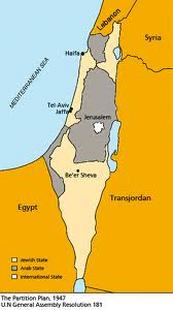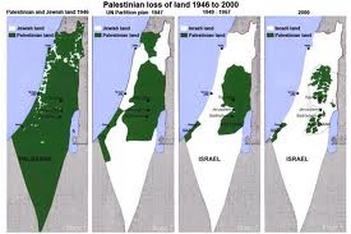Current Situation
Currently, the Palestinians and the Jewish population of Israel are constantly battling each other to decide what state should control the land and how much land should be controlled by each. It is a complicated conflict that originated thousands of years ago. Below is an overview of how the modern conflict sparked and gained momentum as violence and warfare increased over the years.
The War of Independence (1948-1949)
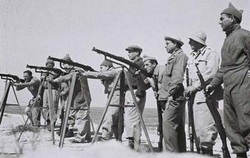
The Israeli war of independence was the spark that caused the century of violence between the Palestinians and the Jews. After the British mandate, or rule of Palestine ended, the region became a Jewish state, Israel. The state of Israel was declared on May 14, 1948 under the UN Partition Plan. The UN Partition Plan split Palestine into a Jewish State and an Arab state. Palestinians were angered by the creation of a Jewish state and argued that the only reason that it was established was because the British permitted some Jewish immigration against their wishes. However, the day after Israel was formed, on May 15, 1948, six nearby Arab nations in support of the Palestinians (Egypt, Syria, Jordan, Iraq, Lebanon, and Saudi Arabia) invaded Israel, starting a war that lasted more than a year. These Arab nations surrounded Israel from all directions and organized Palestinians fought from the interior of the newly established state. After long periods of fighting and smaller periods of cease-fire, the Arab nations were ejected from Israel, armistice agreements were signed with all countries besides Iraq (who simply withdrew), and Israel had gained about 5,000 km more land then they had started with from the UN partition plan. The Israeli forces had started the war as the Haganah, an unprepared underground defense force that had just been formed, and emerged as the IDF, Israeli Defense Force, with over 100,000 soldiers, much more than what they had started with. However, the IDF later became a controversial force in the present-day conflicts of Israel and Palestine.
This war led the Palestinians to acts of terrorism, in order to show others that the war was not over and that they would keep fighting for their rights. Suicide bombers infiltrated the state,
However, this war also caused another huge problem in Israel today: displacing and expelling of Palestinians. As a result of the war, around 726,000 Palestinians became refugees. A large amount of Palestinians were displaced as well, and many lost their homes. Refugees were forced to find shelter in other nations that often did not admit them or live in camps that contained extremely poor conditions and overcrowding.
This war led the Palestinians to acts of terrorism, in order to show others that the war was not over and that they would keep fighting for their rights. Suicide bombers infiltrated the state,
However, this war also caused another huge problem in Israel today: displacing and expelling of Palestinians. As a result of the war, around 726,000 Palestinians became refugees. A large amount of Palestinians were displaced as well, and many lost their homes. Refugees were forced to find shelter in other nations that often did not admit them or live in camps that contained extremely poor conditions and overcrowding.
Sinai Campaigns (1956)
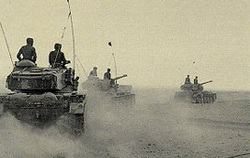
The invasion of the Suez Canal and Sinai Peninsula by Israel was backed and planned by Britain and France against Egypt, who had lost French and British companies in the area. Egypt had also tried to cut off Israel's access to the Red Sea, violating the Israeli-Egyptian armistice, so military action erupted and Israel, Britain, and France invaded Egyptian territory. The armies were victorious in achieving their personal desires, but pressure from the United States and threats from the Soviet Union to intervene caused them to withdraw from the area eventually. This was the second major military action in Israel's history, leading to more tension between the Israelis and the Palestinians with their closely related Arab neighbors.
Six-Day War (1967)

The Six-Day War is justified by Israel's claims that 3 Arab nations: Syria, Egypt, and Jordan, were planning a massive attack on Israel within a matter of days and the only way to prevent this was to invade them first. There is little evidence of this actually happening, but the United Nations forces had just left the Suez region of Egypt that bordered Israel on the Egyptian ruler's request. Once the UN had left the region, Egypt concentrated a large amount of soldiers there. Israel immediately jumped to the conclusion that Egypt was planning on an attack, so this caused the invasion. Israel was largely successful throughout the war, destroying virtually all of their enemy's air force and capturing a significant amount of land, including 30 miles into Syria itself. This was a turning point in the history of this conflict because it is when Palestinians began to lose faith in the governments and military of other Arab nations and began to form their own nationalist and political organizations. They watched Israel dominate a war against 3 other Arab nations and lost faith in them. As a result of this war, 400,000 Palestinians were pushed into Jordan. Many Palestinians, now falling under Israeli rule or being pushed into other nations, were persuaded to join nationalist groups, such as the PLO (Palestinian Liberation Organization).
The Yom Kippur War (1973)
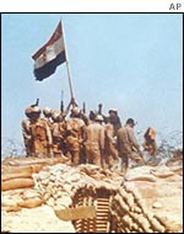
The Yom Kippur war was launched on the day of atonement for the Jews- the holiday known as Yom Kippur. In Jewish culture, this is when they pray for forgiveness for their sins. Most Jews fast on Yom Kippur as well, and is considered an extremely holy day. The Arabs invaded Israel on this day, surprising Israeli government and soldiers. The war was launched by only two nations, Egypt and Syria, but was quickly backed by nine other Arab nations that supplied weapons, planes, and tanks to the forces. Arab nations were not the only ones to support the attack. North African states and even the Soviet Union quickly responded to the call for arms and soldiers. Even Libya paid around $1 billion to Cairo for the war efforts. The US immediately tried to create a cease-fire between the groups, but none was created and the Soviet Union refused to help with this process, resupplying the Arabs by air and by sea. Because the Soviet Union refused to attempt a peace compromise, the US created their own airlift system, supplying Israel by air.
The IDF was vastly outnumbered at the borders, as it was a complete surprise attack. In some regions of the border, 436 Israelis faced 80,000 Egyptians. Within two days of fighting, Israel was on the defensive but eventually slowed the lightning campaign as reserves were mobilized. The invaders were expelled into Syria and Egypt and eventually the Egyptian Third Army was trapped. However, before Israel conflicted again in which would have arguably been a terrible defeat for the Arabs, the UN Security Council interfered and created a cease-fire agreement. The Jews were frustrated and angered by this war, because they had been attacked by surprise on an important day for them. This caused them to be more cautious around the Palestinians and Arabs, and seek vengeance for this diplomatic and military disaster.
The IDF was vastly outnumbered at the borders, as it was a complete surprise attack. In some regions of the border, 436 Israelis faced 80,000 Egyptians. Within two days of fighting, Israel was on the defensive but eventually slowed the lightning campaign as reserves were mobilized. The invaders were expelled into Syria and Egypt and eventually the Egyptian Third Army was trapped. However, before Israel conflicted again in which would have arguably been a terrible defeat for the Arabs, the UN Security Council interfered and created a cease-fire agreement. The Jews were frustrated and angered by this war, because they had been attacked by surprise on an important day for them. This caused them to be more cautious around the Palestinians and Arabs, and seek vengeance for this diplomatic and military disaster.
The Palestinian Liberation Organization (PLO)
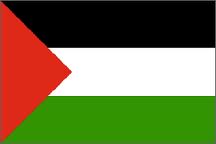
The PLO is largely considered the Palestinians only form of government, led by leader Yasir Arafat, and, to Palestinians, gives hope for the formation of a Palestinian state. It plays an enormous role in the nationalist movement for a Palestinian state. However, the PLO has had a record of terror that has resulted in their organization being recognized as a terrorist group to Israel and many western civilizations. The PLO is currently banned from Israel, and their leader Yasir Arafat has been exiled from the nation. Since the mid 1960s, branches and groups within the PLO held border raids from Jordan and Syria to Israel. These were low-level attacks in the "war of attrition," against Israel. After 1967 and the Six-Day War that left thousands homeless, political passion intensified, and so did the attacks. Organizations and individuals became more active in protesting both violently and non-violently. Israel reacted to the increasing violence by hunting them in whatever countries contained them, such as Jordan or Lebanon. Other countries in the international community blamed Israel for the damages, arguing that the occupation of Arab and Palestinian lands was the cause of the attacks. The PLO indirectly, but successfully, worsened Israel's reputation and made themselves a legitimate movement. For example, in hunting the PLO, Israeli forces killed tens of thousands of innocent civilians and Palestinians in the process. Israeli allies also bombed a Palestinian refugee camp that the Israelis were supposed to be guarding, resulting in a massacre. The world and the Arab world was outraged by this, and Israel's reputation decreased as the PLO movement gained more popularity and world support.
The Intifada (1987-Present-Day)
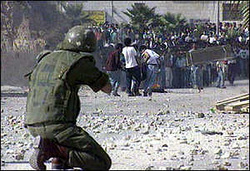
The Intifada, which means to "throw off," was a movement starting in the Gaza Strip, an area with poor conditions that the Israelis have pushed many Palestinians into. The Intifada was designed to get Israel off of Palestinian land and provide resistance to their occupation. It was a result of decades, and (depending on how one perceives history) centuries of tension between the Palestinian population and the Jewish population of Israel. The movement started locally when people began to react to local Israeli soldiers occupying the region. Palestinians protested daily with strikes, demonstrations, and throwing of rocks and even petroleum bombs. The Intifada was not sparked by the PLO or any particular Palestinian group, but the PLO and nationalist groups quickly became a large part of the movement, supplying information booklets, money, and goods via airplane to direct and ultimately take control of the situation. The Intifada resulted in civil unrest, making the occupying soldiers' jobs difficult. The Israelis were allowed to open fire on the citizens participating, but may argue that Israeli soldiers have abused this power, not just in this movement, but in general. Even today there are news stories of soldiers open firing and killing people in protests when it was not necessary. The Intifada led to even more extreme political passion, heating up the conflict. The Intifada indirectly rose the amounts of extreme actions taken against the government by providing everyone with an opportunity to take place in the large-scale movement. The Intifada also brought international attention to the fact that Israel was illegally occupying parts of Palestine for nearly two decades. The movement also brought attention to the measures that the Israeli soldiers used to stop the uprising, which were often considered brutal or unnecessary in nature. The Intifada was, for Israel, the beginning of a shift of looking at the nation's external conflicts to examining the internal conflicts of Israel.
International Intervention & Resolution Attempts
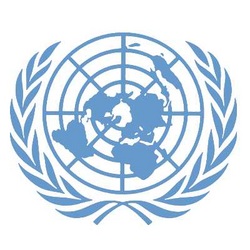
As the Israeli-Palestinian conflict rages on today, many nations have contributed or attempted to aid in making a compromise between the two groups. For instance, France and the USA have supplied Israel with large amounts of weapons, trading with Israel constantly. Israel has often been supported more than Palestinian nations largely because of the influence of organizations considered to be terrorist organizations on the Palestinians. However, in 1988, as part of an agreement, the PLO recognized Israel's right to exist in exchange for the US and many other nations recognizing the PLO. Over the years, as the conflicts have risen in momentum, nations, such as the US, have been more neutral and interested more in peace than helping one side win their battles. Their have been several peace plans and proposals, some of which have contributed in making the conflict less intense, but none of which have stopped the conflict and established equal Palestinian and Israeli states. Recently, US President Barack Obama has given a speech addressing the conflict in Israel and proposing that the nation's borders return to what they were before the Six Days War of 1967. Unfortunately, Israeli President Benjamin Netanyahu declined this proposal, stating that those borders would leave Israel "indefensible." Obama's speech has largely been considered an attempt to stop Palestinians from speaking at the United Nations General Assembly, asking them to recognize some of their Israeli-occupied territory and return to formal negotiations. Many nations do not want Palestinians to do this because if they do, then the terrorist group Hamas of the PLO would become a high position in government, possibly causing more violence between the Palestinians and the Israelis. Attempts have also been made in the past to establish a peaceful Palestinian state alongside the Jewish nation of Israel, such as Former President George W. Bush created a set of steps for the government to take to achieve peace, which involved abandoning Israeli outposts and taking down road blocks. Israel did not take these steps seriously, and did not follow some of these commitments as well, making the plan ultimately a failure. However, there are still peace plans being formulated today, and international efforts are being put forth to create peace in the Middle East.
Continuing Violence
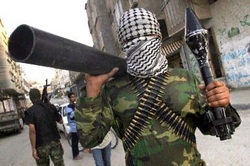
Unfortunately, even though resolution attempts are constantly made, Israel remains in chaos. We hear of the Palestinians launching rockets from Gaza frequently into Israeli territory. Children are used as shields against Israeli fire when terrorist organizations like Hamas or Fatah attack an area. Riots and protests flood the streets. But the Palestinians are not the only ones to blame. In the news constantly are stories of Israeli soldiers firing at non-violent protesters, killing many. Police brutality is used on Palestinians. The Israelis strictly regulate what kinds of goods come into Palestinian-inhabited regions, limiting the standard of conditions they can live in. For instance, in some areas, they will not let construction materials like wood and cement, fearing that they will build catapults, when many Palestinians simply want to build a home. Because of a few "terrorist" groups like Hamas and Fatah, Israel seemingly does not trust any of the Palestinians, at the expense of them.
In this situation, many view Israel as having taken the roll of the aggressor, and the Palestinians taken the role of the rebels. However, the reason that the Israeli-Palestinian conflict is so controversial today is that so many different people view the situation in so many different ways. There are so many arguments for both Israel and Palestine. To view these arguments, click on the picture to the left of this text. There is one thing for sure, though, that the violence and conflict continues to rage on.
In this situation, many view Israel as having taken the roll of the aggressor, and the Palestinians taken the role of the rebels. However, the reason that the Israeli-Palestinian conflict is so controversial today is that so many different people view the situation in so many different ways. There are so many arguments for both Israel and Palestine. To view these arguments, click on the picture to the left of this text. There is one thing for sure, though, that the violence and conflict continues to rage on.
